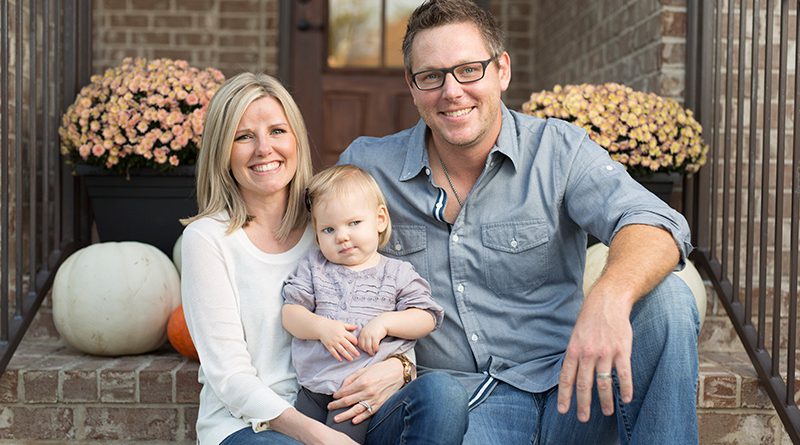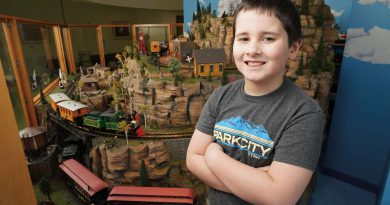Dream Big
Published on February 4th, 2016 by user.
Eighteen-month-old Brooklyn Burney has glistening blue eyes and the best laugh—enough to light up a room. She loves playtime with her dad and snuggling with her mom.
But for 24 hours on July 17, 2014, Laura and Justin Burney felt as if their world stood still inside Monroe Carell Jr. Children’s Hospital at Vanderbilt. A perinatal stroke at birth, followed by a ruptured brain aneurysm at 1 month of age, threatened to derail the Burneys’ dreams of enjoying those experiences they now relish in with their daughter.
“We never wished to be there. No parent does,” said Laura Burney. “But when it became our reality, we were so grateful to have the Children’s Hospital as an amazing resource in our backyard. They saved our daughter’s life.”
To create Children’s Hospital as such a comprehensive resource took decades of vision, enthusiasm and persistence.
And dreams. Monroe Carell Jr. and his wife, Ann, dared to dream big.
In the 1990s, when pediatric health care services were scattered in buildings across Nashville and strained by the demands of a growing population, health care leaders knew a dedicated children’s hospital was needed. But the vision required a champion, someone willing to lead the effort in the community as well as the large-scale philanthropic endeavor that would be required.
At the time, Monroe Carell Jr., a 1959 Vanderbilt graduate and CEO of Nashville-based Central Parking, was already generous with his time and support of what was then Vanderbilt Children’s Hospital, which occupied three floors within the adult Vanderbilt University Hospital. Inspired by his frequent visits to the Neonatal Intensive Care Unit, he assumed the role of chair of the Children’s Hospital Board of Directors.
When he was approached about spearheading philanthropic efforts to support a freestanding children’s hospital, he and Ann happily jumped on board and made a transformational gift. Influenced by his own childhood experiences with hospitalization in a sterile, uninviting atmosphere, Monroe Carell knew if he was going to be involved that the hospital must be inviting, bright, child-friendly and accommodating to families.
With much fanfare, Monroe Carell Jr. Children’s Hospital at Vanderbilt opened to the public in 2004, and it remains the only freestanding, comprehensive pediatric facility in Middle Tennessee. Families quickly filled the space and sought the high-quality, compassionate care provided for everything from broken bones to childhood cancer.
An expansion that added 33 beds and 30,000 square feet in 2012 created additional capacity for acute, surgical and neonatal intensive care services. Those spots filled quickly.
Now the Carell daughters, Julie Carell Stadler, Kathryn Carell Brown and Edie Carell Johnson, are dreaming big too, with the latest expansion endeavor to add four floors of new space atop the existing hospital structure. A $10 million gift from the Carell daughters and their families served as the foundation of a fundraising campaign for the expansion.
“This hospital cares for all children, and this expansion is vitally important so that the hospital can see more children every year,” said Kathryn Carell Brown, who chairs the expansion’s philanthropic campaign, Growing to New Heights.
“Children’s Hospital has such a fabulous reputation, and the expansion will allow us to do even greater things and to provide care for children and families in a loving environment. No child asks to be sick, and we need to do everything we can do to help them heal. These children are our future.”
Patients and families, joined by community supporters and Vanderbilt leaders, gathered in September to celebrate the hospital’s continued commitment to fulfill the growing health care needs of children in Tennessee and throughout the region.
Approximately 300 people attended festivities to sign a 10-foot white beam to mark the expansion milestone and signify the solid infrastructure of community support.
The expansion will allow Children’s Hospital and clinics, which already serve about 1,400 children and families each day, to advance the size and scope of their missions to provide world-class health care, train future generations of pediatricians and pediatric specialists and conduct groundbreaking research that leads to new treatments and cures.
“The outpouring of support from our community is making it possible to expand Monroe Carell Jr. Children’s Hospital at Vanderbilt,” said Vanderbilt University Chancellor Nicholas S. Zeppos. “Led by the Carell family and with enthusiastic participation by many individuals and organizations in our region and beyond, this campaign is truly a community effort on behalf of the children and families who need specialized care. I am grateful to everyone who has joined us so far.”
Each floor of the expansion will add 40,000 square feet to Children’s Hospital. Once construction is complete the hospital’s total size will have increased to nearly 1 million square feet. With the architectural design and engineering phase nearing completion, construction is slated to begin in 2016.
The first two floors to be completed will add intensive care beds for newborns and other critically ill pediatric patients who need treatment for a wide range of serious conditions, including organ transplantation, neurological and neurosurgical ailments and a host of other serious pediatric health issues that require the highest level of care.
“Through the hospital’s expansion we are creating the promise of a brighter future for our most vulnerable patients. We will care for more children and families, train more physicians and nurses dedicated to the care of children, and discover more treatments and cures for devastating childhood diseases,” said Jeff Balser, M.D., Ph.D., vice chancellor for Health Affairs and dean of the School of Medicine. “I am deeply appreciative to the Carell family, to our campaign co-chairs, and to countless other generous supporters.”
Additional features that will be included within the expansion’s first completed floor are: family areas, a playroom, a large waiting room, educational space and patient consultation rooms. The expansion was planned and designed by Donald Blair of Blair + Mui Dowd Architects of New York. Blair has served as planning architect for many of Vanderbilt University’s patient care and research facilities.
The goal of the Growing to New Heights Campaign, which officially launched in October 2014, is to raise $40 million over three years to support the total estimated cost of the building’s $100 million expansion.
Along with Kathryn Carell Brown, co-chairs for the Growing to New Heights Campaign are Kix Brooks, country music artist/entertainer; Rick Dreiling, former chief executive officer, Dollar General Corporation; Steven Hostetter, chief executive officer, TriStar Energy LLC; Bob Rolfe, chief executive officer, Medical Reimbursements of America, Inc.; and artist manager Clarence Spalding, a partner at Maverick.
To date, more than $34 million has been committed toward the philanthropic goal. Additionally, to support the campaign, every member of the Children’s Hospital Board has made a contribution.
“When I think about all that we have accomplished in a little over a year since we started the campaign, I am so proud of our friends and the wider Nashville community. They have joined arms with us to make this expansion possible. So many people have given, sacrificed and made this their priority,” said Kathryn Carell Brown.
“This place is very near and dear to my heart. I am so grateful for my parents, Ann and Monroe Carell. They dreamed big, years ago. And I am excited that so many people are stepping up to join us in this dream and to make the dream continue. My parents would be so proud as well to see the involvement and investment the community has made to make this possible.”
The following two stories reflect on how Children’s Hospital is helping children and families heal and why added space is needed to offer that same care to more families.
‘Super B’
Laura Burney credits the Children’s Hospital care team for her daughter’s survival. She vividly recalls July 17, 2014.
At the suggestion of their Clarksville pediatrician, Jennifer Seawell, M.D., they brought their 1-month-old daughter, Brooklyn, who suffered a perinatal stroke at birth, to Monroe Carell Jr. Children’s Hospital at Vanderbilt.
Just hours earlier, as Brooklyn slept in Laura’s arms, the baby appeared to suddenly stop breathing. A moment later, she was breathing again normally. It happened several times, with her lips turning blue before she started breathing again.
A head measurement at the pediatrician’s office showed that Brooklyn’s head had grown 2 centimeters since her visit a week earlier. Two CT scans at Children’s Hospital revealed the infant had a ruptured brain aneurysm, a weakened area of a brain blood vessel that fills with blood.

In that first day at Children’s Hospital, Brooklyn had two emergency craniotomies—a procedure during which a bone flap of the skull is removed to allow for access to the brain. Blood was pooling inside her skull and putting pressure on her brain. The surgeries helped relieve the pressure and prevent brain damage.
Truc M. Le, M.D., assistant professor of Pediatrics and Neurological Surgery, who was the on-call intensive care physician at the hospital that night, said Brooklyn “wasn’t out of the woods” after her first surgery to relieve pressure, Laura Burney recalls. The goal was to keep Brooklyn stable so the team could do an angiogram which would locate the aneurysm and allow surgeons to clip it in a second surgery. While the Burneys tried to get some rest, a nurse came to get them and bring them to a conference room where Le came in with unexpected news.
“He said Brooklyn’s heart had stopped and they had to do CPR for two minutes,” Laura said. “I didn’t hear anything after that for about five minutes.”
Doctors believed the brain aneurysm re-ruptured, and that’s when John “Jay” Wellons III, M.D., MSPH, chief of the Division of Pediatric Neurosurgery, came in for a brief introductory conversation before a second surgery.
“He said ‘this is not a sit down conversation. If we want to save her life, I have to go now,’” Laura recalls. Because Brooklyn had not remained stable enough to do the angiogram, Wellons had to search for the aneurysm during surgery. Surgeons removed two blood clots that day and part of her frontal lobe.
“In the days and weeks that followed, I was afraid every time a doctor walked into the room that they would tell me her heart stopped again—that was by far the scariest part of all of it,” Laura said.
Brooklyn spent two weeks in the Pediatric Intensive Care Unit (PICU), and quickly earned the nickname “Super B” for her miraculous recovery.
Today, at 18 months old, she has some weakness on her left side, possibly caused by the aneurysm intensifying the damage from her stroke at birth. She does physical and occupational therapy, but is on track with her development thanks to her feisty personality.
Laura credits the incredible teamwork at Children’s Hospital for saving her daughter’s life: the surgeons, the nurses, the anesthesiologist, the Emergency Department staff, the residents and everyone in between.
The Burneys plan to hold a fundraiser in the near future to support Children’s Hospital as a way to say ‘thank you’ for Brooklyn’s great care.
“Because of this place, she is here, and because of this place, she has a future,” Laura said. “With this expansion they’ll have the opportunity to save many more.”
Gloria’s journey
While most parents of newborns document first smiles, weight milestones or their infant’s first taste of rice cereal, Marlene Schmucker jotted down details of the hourslong surgeries, feedings, suctioning and pain medication of her firstborn’s early months—all spent in the Neonatal Intensive Care Unit at Monroe Carell Jr. Children’s Hospital at Vanderbilt.
Marlene intimately documented her daughter Gloria’s first five months in two journals, detailing her treatment and care for esophageal atresia, which means the esophagus—the tube that connects the mouth to the stomach—hadn’t formed correctly. She also had trachea-esophageal fistula, a condition in which the trachea (the tube that connects the throat to the windpipe leading to the lungs) had an abnormal connection to the esophagus. A suction tube was placed in her mouth since she couldn’t swallow liquids or saliva. Initially, she had a feeding tube inserted in her stomach to give her the nutrition she needed.
The family’s journey began when Gloria, now 3, was born prematurely at 33 weeks, despite no signs during Marlene’s pregnancy that she might make an early appearance. Marlene went into labor during a trip to visit her parents in Virginia, about nine hours away from her Franklin, Kentucky, home.
With labor progressing too slowly and the baby’s heart rate dropping, Virginia doctors delivered Gloria by emergency cesarean. She weighed 3 pounds, 8 ounces and was 16 inches long.
“(The neonatologist) tried to pass a suction tube into her throat and he couldn’t get it down. He called my husband over and told him the situation and that she was also missing her right thumb,” Marlene said. “We were very disappointed and heavy-hearted. You expect to deliver a normal, healthy child with no issues and then, bam. It was hard, especially not to know what all the future held.”
With Nashville, Tennessee, close to their home, the Schmuckers made the decision to have 2-day-old Gloria transferred to Children’s Hospital for surgery to repair her esophageal and tracheal defects. The Angel transport flight crew arrived to bring her to Children’s Hospital. The Schmuckers drove from Winchester, Virginia, to Nashville to be with Gloria.
“I tell people it was the hardest thing I have ever done—to let her go with perfect strangers. You worry about what might happen during the flight. The team set our minds at ease and we knew she was in good hands,” Marlene said.
Marlene and her husband, Martin, arrived around midnight at Children’s Hospital, holding their daughter in the hours leading up to her scheduled surgery with Dai Chung, M.D., chair of the Department of Pediatric Surgery and the Janie Robinson and John Moore Lee Professor of Pediatrics.
During a six-hour surgery, Chung was able to repair the fistula, but the gap to repair the esophagus was too wide to repair fully. To encourage the esophagus to grow, suture strings were laced through Gloria’s back so her care team could tighten them daily until the esophagus ends could be attached in another surgery.
Two weeks later, another surgery was attempted to repair the atresia and connect the gap between the two ends of the esophagus. But the gap was still too large. Another surgery likely would be needed to make the repair when Gloria was 6 months old.

“Six months to us sounded like an eternity, and she would need to stay in the NICU the entire time,” said Martin.
The Schmuckers settled into a routine, staying at the Ronald McDonald House and spending as much time with Gloria as possible.
“She was stable, growing and a happy baby. The thing that caused the most stress was the tube inside her mouth would get clogged and they would have to change it out. She would breathe harder. It was scary to watch,” Marlene said.
Then when Gloria was 4 months old, William F. Walsh, M.D., chief of nurseries at Children’s Hospital, and her care team noticed formula in the suction tube inside her mouth, which would only be possible if her esophagus connected to her stomach.
“The surgery we thought was going to happen was no longer needed. We believe that was a miraculous answer to prayer. After nine procedures to stretch that connection,
Gloria now eats normally and is a very spunky 3-year-old,” said Martin. “We cannot say enough about our incredible team of nurses and doctors. During our entire five-month stay they always treated us with respect, and Gloria received outstanding care.”
– Christina Echegaray




